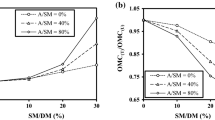Conclusions
The addition of 20% finely ground kyanite-sillimanite concentrate or electrocorundum slurry to the aluminosilicate concretes based on kaolin chamotte with phosphate and alkali-silicate bonds contributes to the formation in the body, at high temperatures, of a ceramic bond with a well developed mullite phase, which improves the thermal properties of the material.
The introduction of the same quantities of kyanite-sillimanite to the concretes based on aluminous cement somewhat impairs their thermal properties.
The use of sillimanite concentrate containing large quantities of impurities (iron oxides and fusible minerals) impairs the thermal properties of the aluminosilicate concrete.
The use in the composition of refractory concrete of kyanite-sillimanite concentrate in the natural grain state, not requiring additional grinding and thermal processing, or the use of waste from the abrasive industry, is economically desirable, and can be recommended for use in industry.
Similar content being viewed by others
Literature cited
A. A. Pirogov et al., Sbornik Trudov UNIIO, No. 8, 116 (1965).
A. I. Zherdeva and V. K. Abulevich, Mineral Raw Materials, Sbornik Trudov VIMSa, No. 1 (1960).
V. I. Goncharov et al., Ogneupory, No. 10, 10 (1965).
J. W. Greig, J. Amer. Ceram. Soc.,8, No. 8, 464 (1925).
L. A. Tikhonova, Ogneupory, No. 6, 255 (1960).
E. Overkott et al., Ber. Dtsch. keram. Ges.,42, No. 5, 197 (1965).
V. D. Svikis, Amer. Ceram. Soc. Bull.,38, No. 5, 264 (1959).
J. C. Banerjee et al., Tonind.-Ztg, Nos.11/12, 257 (1963).
P. P. Budnikov et al., Chemistry and Technology of Building Materials and Ceramics [in Russian], Gosstroiizdat (1965) p. 39.
L. A. Tseitlin and A. A. Eltysheva, Ogneupory, No. 1, 34 (1962).
S. Pawlowski, Mater. ogniotr., No. 3, 51 (1963).
N. E. Filonenko and O. S. Kuznetsova, Ogneupory, No. 10, 470 (1952).
T. Horibe and S. Kuwabara, Kogyo kagaku zasshi,67, No. 12, 2033 (1964).
E. V. Ermolaeva, Ogneupory, No. 4, 162 (1951).
G. V. Kukolev and A. I. Roizen, Ogneupory, No. 2, 65 (1949).
Author information
Authors and Affiliations
Additional information
Translated from Ogneupory, No. 12, pp. 30–38, December, 1967.
Rights and permissions
About this article
Cite this article
Pirogov, A.A., Yutina, A.S. & Drizheruk, M.E. Effect of the nature of aluminous additives on mineral formation and properties of aluminosilicate concretes. Refractories 8, 752–759 (1967). https://doi.org/10.1007/BF02055731
Issue Date:
DOI: https://doi.org/10.1007/BF02055731




